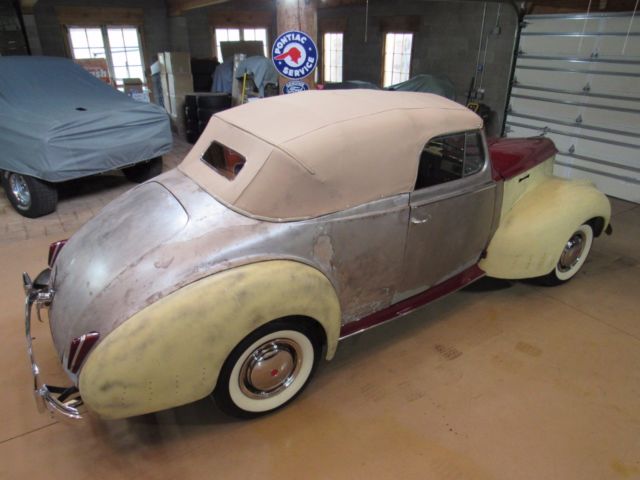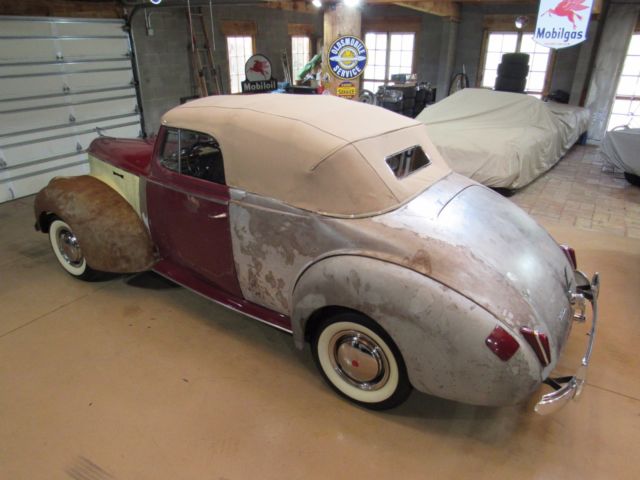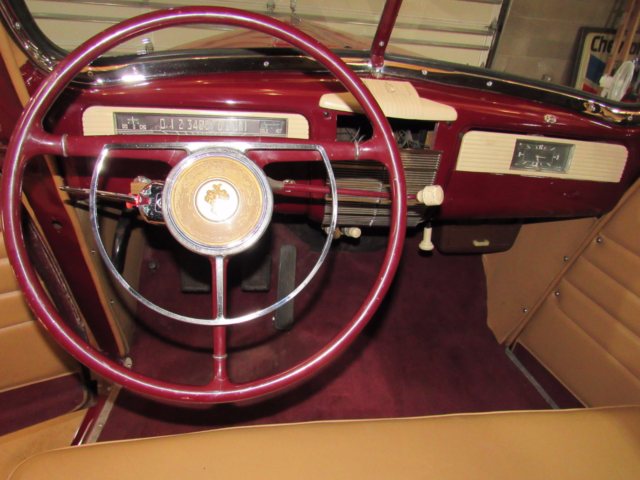1942 Packard 110 Convertible Rare WW2 era war time production car
- Price:
- Location: Cave Creek, Arizona, United States
- Make: Packard
- Model: 110
- Type: Convertible
- Year: 1942
- Mileage: 85,371
- VIN: E9852
- Color: Burgundy
- Engine size: 6 cylinder
- Number of cylinders: 6
- Fuel: Gasoline
- Transmission: Manual
- Drive type: RWD
- Vehicle Title: Clear
1942 Packard 110 Description
For Sale with clean Arizona title in name! 1942 Packard 110 Convertible Running Project Needs restoration, Very solid chassis and drive train factory 6 cylinder motor will start and run but obviously needs a tune up and fresh fuel, does drive forward and backwards but has no brakes from sitting so it will need non operational shipping! What you see in the photos is what you get there are a few trim and accessory pieces missing ect. Truly a rare WW2 era Produced Packard Delivered to Beverly Hills Packard in January 1943. With State of California DMV records documentation and story passed down that the car was believed to be previously owned by President Ronald Reagan during the time of his film career in California. This is a rare opportunity to own a very special car if you have any questions please call Andy at 480-848-2838 Please no calls after 9pm, Leave a voicemail and I will return your call asap! Bid to win, with a conservative reserve you can actually own this car! Can help with shipping, and special payment arrangements ect..1940’s Automobile Production
By February of1942, all of the majorautomobile makers had their production lines shut down as a result of a production freeze on their 1940’s automobiles.All existing stock of unsold cars weremanaged byour government for the war effort. These cars were the leftover 1941 and 1942 models, and were rationed out on an as-needed basisfor civilian and military use.
In general terms, no 1940’s automobiles were produced in 1943 or 1944. With that said, the auto industryclaims there were 139 cars built in 1943 and 610 built in 1944.It could very well be that they used up the existing stock of vehicles and made more,but theywere probably assembled from spare parts left over after the assembly lines shut down.
Itgets alittle complicated getting an accurate count, for afew reasons:
1. Some of the1941 and 1942 models that were left over before the freeze were taken byour military for staff cars, and were titled as 1943, 1944, and 1945 models.
2. War Department document TM-9-2800 from 1943 authorized building certain light and heavy cars for staff use, the light ones were Chevrolet, Ford, and Plymouth, while the heavy ones were Packard and Buick.Again, these were either leftover vehicles repainted for military use, or built with leftover parts.
3. Fred Crismon’s bookU.S. Military Wheeled Vehicles(Crestline Series) says that Packard was building blackout versions of the Clipper “as late as 1943” for the U.S. Army.
Production started up again in 1945, although these automobiles were builtfor the 1946 model year. Most makes that were builtwere warmed over 1942 models for 1946, 1947 and 1948. For example, General Motors first postwar redesign was their 1949 line ofautomobiles.
During the production freeze, automakers became around the clock defense contractors.
Long before the United States entered World War II, automobile manufacturers began devoting ever greater amounts of production time to defense work, for export to Britain as well as for the United States. The Chrysler Corporation was one of the car makers most active in defense work. As the involvement of the United States in the war became imminent, the automobile industry played a more important role than ever in the rearmament of the country.
Ford built airplane engines for the British government. B-24 Liberator and gliders bombers for the U.S. Military. Ford also turned out tanks, armored cars, jeeps and engines for robot bombs. Ford’s plants in Great Britain and Canada had joined the production efforts of the United States and produced everything from mobile canteens to four-wheel-drive trucks and autos, grenades, bombs and engine-powered landing craft.
General Motors converted all of its production to the war effort and delivered more than $12 billion worth of goods, ranging from airplanes to tanks, marine diesel engines, trucks, machine guns, and shells. No other manufacturer delivered as much material to the Allied forces.
Chrysler made everything from fuse bomb noses, forging and machining shells, cartridge cases,tanks, anti-aircraft guns, aircraft engines, andthey played a major role in the B-29 bomber. They also made assorted military vehicles such as command cars, ambulances, trucks, and weapons carriers.
At its vast Willow Run plant in Ypsilanti, Michigan, the Ford Motor Company performed somethingof a miracle 24-hours a day. The average Ford car had some 15,000 parts. The B-24 Liberator long-range bomber had 1,550,000. One of the B-24s came off the lineevery 63 minutes.
America launched more vessels in 1941 than Japan did in the entire war. By the end of the war, more than half of all industrial production in the world would take place in the United States.
Without the massive amounts of equipment produced by millions of men and women on the homefrontfor use by the 11+% of the population in the uniforms of the Armed Forces, the results of the war would have been quite different.
COPY AND PASTE THIS DIRECT LINK TO VIEW THE SCANNED CALIFORNIA DMV RECORDS
http://i1149.photobucket.com/albums/o595/NUPROCESS/1942-3_zpshwvh7r6i.jpg
 1942 Packard convertible 110-Rare Pre War limited production Limited production
1942 Packard convertible 110-Rare Pre War limited production Limited production
Mileage: 1
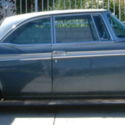 1958 Packard Starlight 2 Door Hardtop, 1950s, rare, fiberglass, low production
1958 Packard Starlight 2 Door Hardtop, 1950s, rare, fiberglass, low production
Mileage: 61,182
 1942 Packard 110 Convertible
1942 Packard 110 Convertible
Mileage: 72427
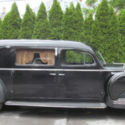 Rare 1942 Packard Henney 120 Hearse Funeral Car Original Complete Survivor More
Rare 1942 Packard Henney 120 Hearse Funeral Car Original Complete Survivor More
Mileage: 69,000
 1942 Packard 120 Convertible Coupe
1942 Packard 120 Convertible Coupe
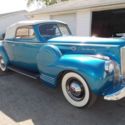 1942 Packard...160 Series...Convertible Coupe...
1942 Packard...160 Series...Convertible Coupe...
Mileage: 68,652
 Rare 1942 Packard Henney Hearse Funeral Car Orig Complete Survivor Clear Title
Rare 1942 Packard Henney Hearse Funeral Car Orig Complete Survivor Clear Title
Mileage: 69,000
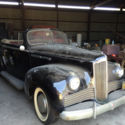 1942 Packard 110 Convertible 1 family preservation barn find!
1942 Packard 110 Convertible 1 family preservation barn find!
Mileage: 69,142
 1942 PACKARD 110 CONVERTIBLE--ONE FAMILY IN PLACENTIA ,CA OWNED---ORIGINAL
1942 PACKARD 110 CONVERTIBLE--ONE FAMILY IN PLACENTIA ,CA OWNED---ORIGINAL
Mileage: 69,159
 1942 Packard 160 "One-Sixty" Convertible Super 8 #2027 35,472 Actual Miles AACA
1942 Packard 160 "One-Sixty" Convertible Super 8 #2027 35,472 Actual Miles AACA
Mileage: 35472




